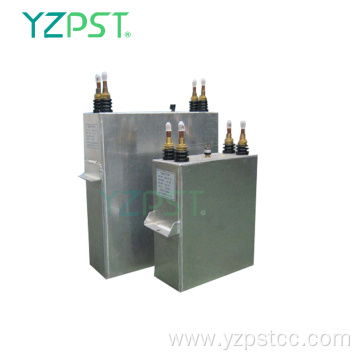The power capacitor is a compensation device that supplies reactive power to the power system, which can improve the power factor, reduce the loss during the transmission process, and thereby reduce the line for carrying the current. Therefore, the safe operation of power capacitors and fault handling are very important. This paper mainly analyzes the common problems and faults in the operation of power capacitors, and proposes corresponding measures and methods for troubleshooting.
Power capacitors are capacitors used in electrical equipment and power systems. Simply put, any two metal conductors are taken, and the conductors are separated by an insulating medium to form a capacitor. The size of the capacitor capacitor is determined by the geometry of the two metal conductors and the characteristics of the dielectric between the two plates. There are many types of power capacitors, and they can be classified into many types according to their standards. Currently widely used are smart power capacitors. The main application areas are the power distribution system of the factory, the power distribution system in the residential area, the traffic tunnel power distribution system, and so on. The main feature of this type of capacitor is its modular structure, small size, simple field wiring and easy maintenance. Power capacitors play an important role in improving equipment utilization and improving power quality. However, in the long-term work operation, due to the influence of the environment and human factors, power capacitors often fail, which seriously affects the power transmission and threatens the operation of the power system.
1 Common problems and countermeasures of power capacitors
1.1 oil seepage
This is a phenomenon that often occurs in capacitor operation, which is mainly caused by a weak or incomplete seal. The capacitor should be a fully sealed device. Once the seal is not tight, air, moisture and other impurities may enter the inside of the tank, which may cause damage to the insulation. The harm of this kind of situation to power capacitors is very large, so it is necessary to prevent this from happening.
In fact, the main part of capacitor leakage is in the tank weld and casing, which requires a strict requirements on the welding process, and manufacturers should also conduct a sealing experiment with a serious attitude, it is necessary to test one by one. Leakage, strictly in accordance with the test requirements. As for the oil leakage part of the casing, it is mainly the welding cap such as the cap, the bolt and the root flange. The solution is to upgrade the processing technology and optimize the design of the structure. This is because if the welding strength of the bolt and the cap is poor, applying a slightly larger tightening force to it will cause it to be desoldered; in addition, if the worker is carrying the casing directly or during transportation, it is incorrect. Mode handling also cracks the weld. In short, in order to avoid such oil leakage faults in capacitors, it is necessary to strengthen the management of manufacturers and maintenance personnel. When there is a slight leak, it can be repaired with epoxy resin and tin, or it can be embedded in the crack with soap to keep it for a short time; however, if it has become a crack, the capacitor must be replaced in time.
1.2 Poor insulation
There are two main reasons for this type of phenomenon.
(1) Excessive capacitance value.
In the test of the service life, the capacitance value does not change much when the voltage is heated for a long time. If the capacitance value suddenly rises, the reason can only be judged as a short circuit due to the breakdown of the capacitive element portion. This is because the capacitor is composed of many components in series. If the number of series segments is reduced, the increase in capacitance occurs. In contrast, the decrease in capacitance is due to the disconnection of some components.
(2) The dielectric loss angle is too large.
For long-running capacitors, the dielectric loss angle will increase somewhat, but the increase will not be very large. If there is a multiplication phenomenon, it must be a fault. This phenomenon is generally caused by local overheating and partial discharge.
In the case of poor insulation, we generally take the replacement of components. It should be noted that if the circuit breaker trip occurs, if the fuse of the shunt fuse is not yet blown, in order to ensure the safety of the employee, the capacitor must be discharged for more than 3 minutes before it can be inspected. In short, it is necessary to strengthen the inspection, timely discover hidden dangers and carry out corresponding troubleshooting and treatment.
1.3 Power capacitor explosion
In recent years, there have been fewer explosions of power capacitors, but the root cause is the free discharge between the poles, which causes the breakdown between the capacitors. In general, as long as the capacitor is equipped with a suitable fuse for protection, its amperage characteristics will not be higher than the burst characteristics of the fuel tank. In the event of a capacitor short-circuit breakdown, the fuse cuts off the power supply, thereby avoiding an explosion accident, while eliminating the risk of fire and the possibility of damaging nearby capacitors.
In order to avoid the occurrence of explosion accidents, star wiring is generally adopted, which is the commonly used explosion-proof measures. In addition, the use of full-film capacitors can also effectively avoid the occurrence of explosions. The difference between a full-film capacitor and a paper-film capacitor in the event of a short-circuit breakdown between the electrodes is that the components of the composite film of the paper film and the full-film are subjected to a high temperature after partial discharge, and the insulating paper is carbonized and carbonized. The paper has a certain degree of isolation, so that the discharge can last for a while. During this period, a large amount of gas will be generated. If there is no fuse to protect it at this time, the fuel tank will burst; the full-film capacitor will not, and the whole film will melt under the action of high temperature, so that the two electrodes will contact each other. If there is no arc discharge, the explosion will naturally be avoided.
1.4 Influence of ambient temperature
There are strict requirements on the temperature around the capacitor, neither too high nor too low. Once the ambient temperature is too high, the capacitor will not be able to dissipate heat normally when it is working; and if the ambient temperature is too low, the oil in the capacitor will freeze and it will be easily broken down. According to the relevant conditions of use of the capacitor, 40 ° C is generally the upper limit of the ambient temperature of the power capacitor when operating. In most parts of the country, the temperature is lower than this temperature, so it is generally not necessary to use special facilities to cool it. However, if there is a heat source near the capacitor, it may cause the temperature to rise above 40 °C. At this time, it is necessary to take corresponding measures to cool it, otherwise the capacitor must be cut off immediately. There is also a lower limit on the ambient temperature at which the capacitor operates, but it should be determined based on the type and nature of the capacitor. In particular, the medium used in the YY type capacitor is mineral oil, so even if the temperature is lower than -45 ° C, there is no freezing problem; and for the YL type capacitor, since the medium used is easy to freeze, The ambient temperature set for it will also increase, which should be higher than -20 ° C. Therefore, such capacitors are generally not used in winter in northern China.
2 Conclusion
According to the above, we can understand some common faults and solutions for power capacitors. In addition, there are many common troubleshooting measures. For example, when a capacitor is injected or caught, the operator should immediately disconnect the circuit and use it. Sand or dry fire extinguishers extinguish the fire. In addition, there are many safety issues to be aware of for capacitor troubleshooting. In actual work, we should consider various influencing factors, minimize the existence of unsafe hidden dangers, and ensure that the capacitors operate under an appropriate condition, so that the power capacitors can operate stably and better serve humans.







